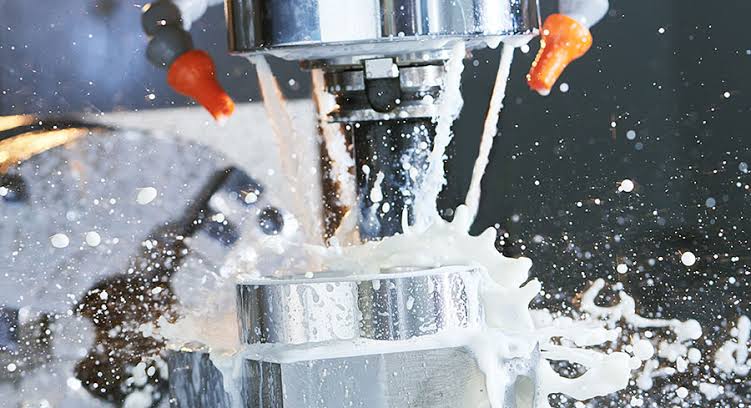How Does Coolant Selection Affect CNC Machining Stainless Steel?
A CNC machine cutting stainless steel with coolant applied to manage heat and reduce friction.
Stainless steel is known as a notorious material for being difficult to machine. It generates a lot of heat and can quickly wear down cutting tools if not handled properly. This is where coolant comes into the picture.
Coolants are more than just liquids that keep things cool; they play a critical role in machining operations. They help manage heat, reduce friction, and even prevent chips from sticking to the cutting tools. Without the right coolant, the entire process can slow down, tools may wear out faster, and the final product might not meet the desired quality.
For stainless steel, the choice of coolant becomes even more crucial because of the metal’s unique properties. Picking the wrong coolant can lead to poor finishes, amongst other issues. But how exactly does the type of coolant you select influence the machining process? This article will explain all you need to know and tips for choosing the right CNC coolant for stainless steel grades.
The Role of Coolant in Stainless Steel Machining
When machining stainless steel, things can get challenging because the material is tough and generates a lot of heat. This is where coolant becomes very important. Coolants are special liquids or oils used during machining to keep the cutting tools and workpiece cool. They help reduce the heat caused by friction and prevent the tools from wearing out too quickly.
But that’s not all. Coolants also make the process smoother by reducing friction, which means the tools can cut through stainless steel more easily. They also wash away the tiny metal pieces, called chips, to keep the work area clean and avoid scratches on the finished product.
Using the right coolant is key when working with stainless steel. It helps improve the tool’s lifespan, gives a better surface finish, and keeps the machining process more efficient. In short, coolants play a big role in making stainless steel machining faster, smoother, and more cost-effective.
Types of Coolants: Oil-Based, Water-Based, and Synthetics
Close-up of coolant being applied to a stainless steel surface during CNC machining to prevent overheating
Coolants are an important part of machining, helping to manage heat and make cutting easier. There are three main types of coolants: oil-based, water-based, and synthetic. Each type works differently and has its own benefits.
Oil-Based Coolants:
These are made from oils like mineral oil or vegetable oil. They are thick and provide excellent lubrication, which helps reduce friction during cutting. Oil-based coolants are great for tough materials like stainless steel because they protect tools and improve the surface finish. However, they can be messy and harder to clean up.
Water-Based Coolants:
These are a mix of water and other chemicals. They are good at cooling because water absorbs heat quickly. Water-based coolants are widely used for their cooling efficiency, but they may not lubricate as well as oil-based ones. Proper maintenance is needed to prevent rust and bacterial growth.
Synthetic Coolants:
These are made from man-made chemicals and contain no oil. They are clean and easy to manage. Synthetic coolants offer both cooling and lubrication, making them versatile. They also last longer and don’t produce as much smoke or residue.
How Coolants Prevent Heat Build-Up and Tool Wear
Coolants are specially designed fluids that help control heat during machining. They do this in two main ways: by cooling the tool and workpiece and by reducing friction. Here’s a detailed explanation:
Cooling the Tool and Workpiece
When machining is underway, the cutting tool and the material heat up quickly. If this heat isn’t removed, the tool can lose its sharpness and even break. Coolants absorb this heat and carry it away from the tool and workpiece. Water-based coolants, in particular, are very effective at cooling because water has excellent heat-absorbing properties. By keeping the temperature under control, coolants protect the tool and ensure the material doesn’t warp or overheat.
Reducing Friction
Friction is another source of heat during machining. As the cutting tool moves through the material, friction between the surfaces creates additional heat and wear on the tool. Coolants act as lubricants to reduce this friction. Oil-based coolants are especially good at this because they create a slippery layer between the tool and the material. This lubrication not only minimizes heat but also makes cutting smoother and reduces the strain on the tool.
Preventing Tool Wear
Tool wear happens when the cutting edges of the tool degrade over time. High temperatures can accelerate this process, making tools dull faster and leading to more frequent replacements. Coolants help by keeping the tool cooler and reducing the stress caused by friction. Synthetic coolants, for example, are designed to offer both cooling and lubrication, making them highly effective in prolonging tool life.
Improving Chip Removal
During machining, small metal pieces, called chips, are formed. These chips can build up around the cutting area, causing more friction and heat. Coolants help wash away these chips, keeping the cutting zone clean and free from debris. This ensures smoother cuts and prevents damage to the tool or workpiece.
Boosting Efficiency and Quality
By managing heat and reducing tool wear, coolants make the machining process more efficient. They allow higher cutting speeds and improve the surface finish of the final product. A well-chosen coolant can save time and money by reducing downtime for tool replacements and improving the overall quality of the work.
Choosing the Right Coolant for Stainless Steel Grades
In order to effectively choose a coolant that meets the demands of stainless steel machining while ensuring efficient and cost-effective operations, you should follow these tips:
1. Control Heat Efficiently:
Choose a coolant with excellent heat-absorbing properties to manage the high heat generated during machining. Water-based coolants are ideal for this because they quickly absorb and dissipate heat, preventing the tool and material from overheating.
2. Provide Effective Lubrication:
Select a coolant that reduces friction between the cutting tool and stainless steel. Oil-based coolants work best for this, as they create a smooth layer that minimizes friction and prevents tool wear during tough machining operations.
3. Facilitate Chip Removal:
Use a coolant that helps flush out chips from the cutting area to avoid chip buildup. Synthetic coolants are particularly effective in keeping the machining area clean and ensuring a smoother cutting process.
4. Prevent Corrosion:
Ensure the coolant is designed to protect both the stainless steel and the machine from rust. Properly maintained water-based or synthetic coolants can achieve this by including anti-corrosion additives.
5. Reduce Tool Wear:
Opt for a coolant that balances cooling and lubrication to protect cutting tools. Coolants with advanced formulations, such as synthetic or oil-based options, can prolong tool life by minimizing wear and maintaining tool sharpness.
6. Match Coolant to Operation Type:
Tailor your coolant choice to the specific machining process, such as milling, drilling, or turning. For example, high-speed milling benefits from synthetic coolants, while deep drilling in tougher stainless steel grades may require oil-based coolants for optimal lubrication.
7. Maintain Coolant Quality:
Regularly check the coolant for contamination and ensure it is diluted properly. This helps the coolant maintain its performance, extending its lifespan and improving machining results.
Maintaining Coolant Systems for Optimal Performance
A technician monitoring coolant levels and concentration for optimal CNC machining performance on stainless steel.
Without proper care, coolant systems can become less effective, leading to increased costs, tool wear, and even machine damage. Here’s a detailed explanation on how to maintain coolant systems for optimal performance.
1. Regularly Check Coolant Levels
Coolant levels can drop over time due to evaporation, leaks, or splashing during machining. Low coolant levels reduce the system’s ability to cool and lubricate effectively. To prevent this, regularly inspect the coolant tank and refill it to the recommended level. Using a coolant mixture that is properly diluted ensures the system operates efficiently and maintains the desired properties.
2. Monitor Coolant Concentration
The effectiveness of a coolant depends on its concentration. If the coolant is too diluted, it may not provide enough lubrication or rust protection. On the other hand, a coolant that is too concentrated can be sticky, cause tool buildup, or lead to higher operating costs. Use a refractometer to measure the concentration regularly and adjust it as needed based on the manufacturer’s recommendations.
3. Prevent Contamination
Coolant contamination is a common problem that can affect performance. Contaminants like dirt, metal chips, and oil from the machine can mix with the coolant and reduce its effectiveness. To avoid this, clean the coolant tank and filters regularly. Installing skimmers or separators can help remove tramp oil and debris, keeping the coolant clean and prolonging its life.
4. Maintain Proper pH Levels
The pH level of the coolant is important for preventing corrosion and bacterial growth. A coolant that is too acidic can damage the machine and tools, while a pH that is too high can cause scaling and other issues. Use pH test strips to monitor the coolant’s pH levels and add additives if needed to keep it within the recommended range, typically between 8.5 and 9.5.
5. Control Bacterial Growth
Bacteria and fungi can grow in coolant systems, especially in water-based coolants. These microorganisms can create foul odors, clog filters, and reduce the effectiveness of the coolant. To prevent bacterial growth, regularly clean the system and use biocides or antimicrobial additives as recommended by the coolant manufacturer.
6. Flush and Replace Coolant Periodically
Even with regular maintenance, coolant loses its effectiveness over time. It can become saturated with contaminants, lose its cooling and lubricating properties, or develop a foul smell. To avoid these issues, flush the system and replace the coolant periodically. The replacement schedule depends on the type of coolant, the machining conditions, and the manufacturer’s guidelines.
Conclusion
Coolant selection plays a crucial role in CNC manufacturing services, directly influencing the quality of the process and the final product of stainless steel. The right coolant ensures efficient heat management, reduces tool wear, and improves surface finishes, while the wrong choice can lead to costly tool damage, machine downtime, and compromised product quality.
What makes coolant selection so important is its ability to adapt to the unique properties of stainless steel, a material known for its strength and resistance. A well-chosen coolant not only protects the tools but also enhances productivity by maintaining stability during high-speed operations thereby delivering exceptional results with every cut.






